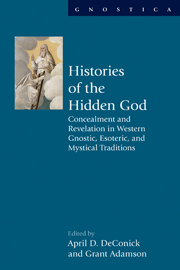 Histories of the Hidden God
Histories of the Hidden God Book contents
- Frontmatter
- Contents
- Acknowledgments
- Contributors
- Introduction: In search of the hidden God
- Part I Concealment of the Hidden God
- Part II The Human Quest for the Hidden God
- 6 Obscured by the scriptures, revealed by the prophets: God in the Pseudo-Clementine Homilies
- 7 How hidden was God? Revelation and pedagogy in ancient and medieval Hermetic writings
- 8 From hidden to revealed in Sethian revelation, ritual, and protology
- 9 Shamanism and the hidden history of modern Kabbalah
- 10 Dreaming of paradise: Seeing the hidden God in Islam
- Part III Revelations of the Hidden God
- Afterword: Mysticism, Gnosticism, and esotericism as entangled discourses
- Bibliography
- Index
9 - Shamanism and the hidden history of modern Kabbalah
from Part II - The Human Quest for the Hidden God
- Frontmatter
- Contents
- Acknowledgments
- Contributors
- Introduction: In search of the hidden God
- Part I Concealment of the Hidden God
- Part II The Human Quest for the Hidden God
- 6 Obscured by the scriptures, revealed by the prophets: God in the Pseudo-Clementine Homilies
- 7 How hidden was God? Revelation and pedagogy in ancient and medieval Hermetic writings
- 8 From hidden to revealed in Sethian revelation, ritual, and protology
- 9 Shamanism and the hidden history of modern Kabbalah
- 10 Dreaming of paradise: Seeing the hidden God in Islam
- Part III Revelations of the Hidden God
- Afterword: Mysticism, Gnosticism, and esotericism as entangled discourses
- Bibliography
- Index
Summary
This essay is part of a series of studies tracing central themes in the history of modern Kabbalah. While classical Jewish studies have generally focused on late antiquity and the Middle Ages, currently one can discern a shift towards a far greater concern with the modern period, in which most of the Kabbalistic literature that has reached us was actually composed. Furthermore, rather than being a residual and soon-to-disappear relic, as in Gershom Scholem's secular-Zionist narrative, Kabbalah is increasingly being portrayed as a vibrant stream within the very process of modernization. As we shall see, adopting this new perspective requires abandoning the meta-narrative of modernity as secularization, and joining the growing body of work known as post-secular. The apparent history of modern Kabbalah is certainly more readily accessible than its nebulous origins, due to developments such as the print revolution and the current rapid digitization of Jewish books. However, following the guiding premise of this volume and the conference upon which it is based, I shall address here its hidden history, whose very existence may not be obvious to all scholars of this lore. This term has three meanings. First, I believe that I have exposed a subterranean current, as it were, which runs below the stream of modern Kabbalistic transmission. The very exposure of the secret is indebted to its partial disclosure in contemporary Kabbalistic writing, as part of the more general process of the exotericization of Kabbalah during the last and current centuries. From here we shall follow the textual record almost exclusively.
- Type
- Chapter
- Information
- Histories of the Hidden GodConcealment and Revelation in Western Gnostic, Esoteric, and Mystical Traditions, pp. 175 - 192Publisher: Acumen PublishingPrint publication year: 2013
